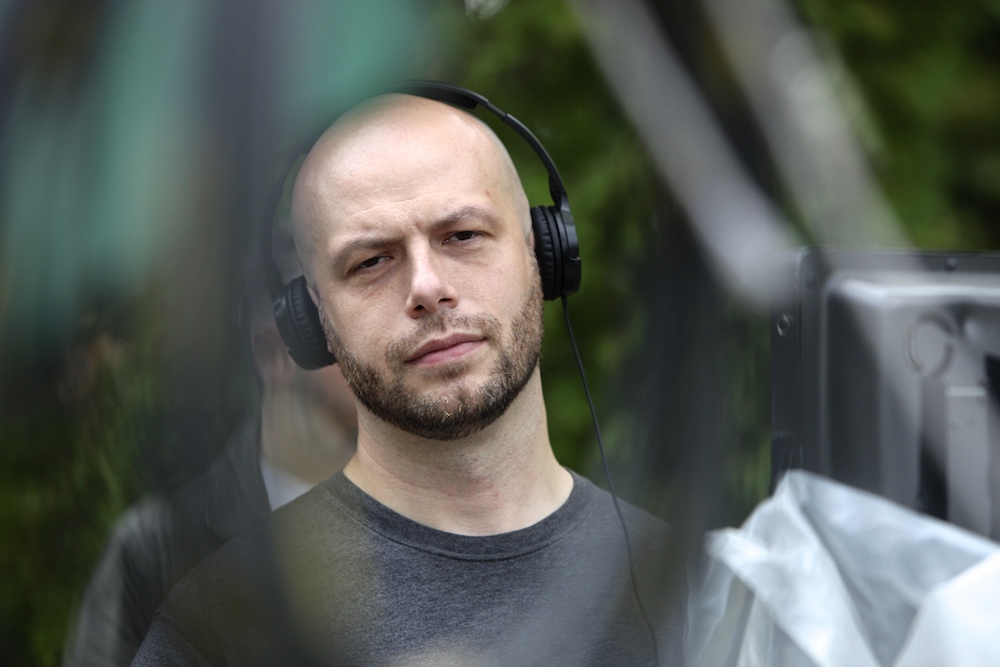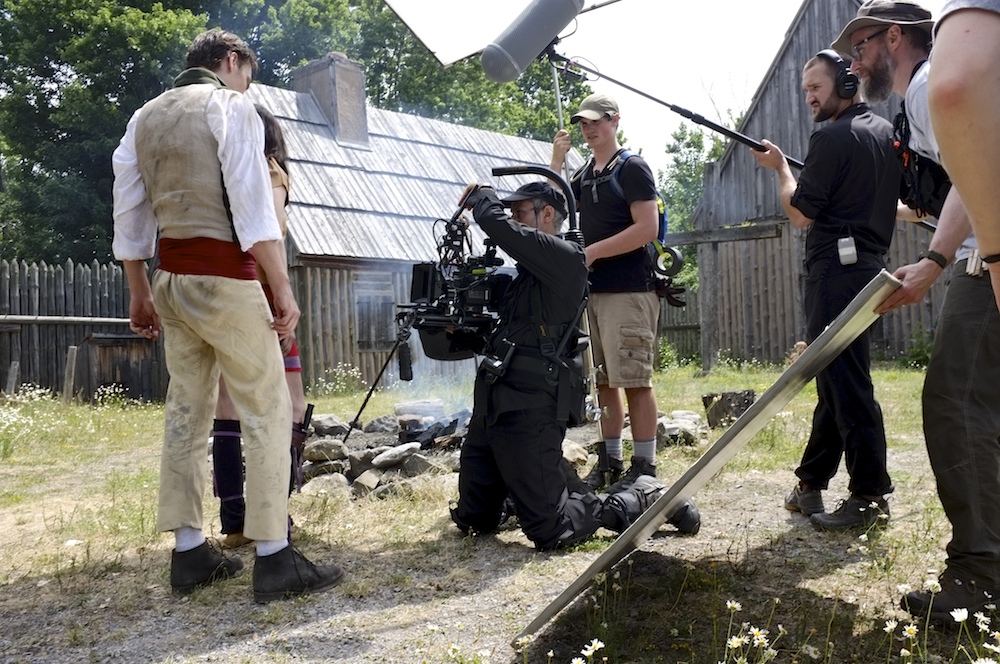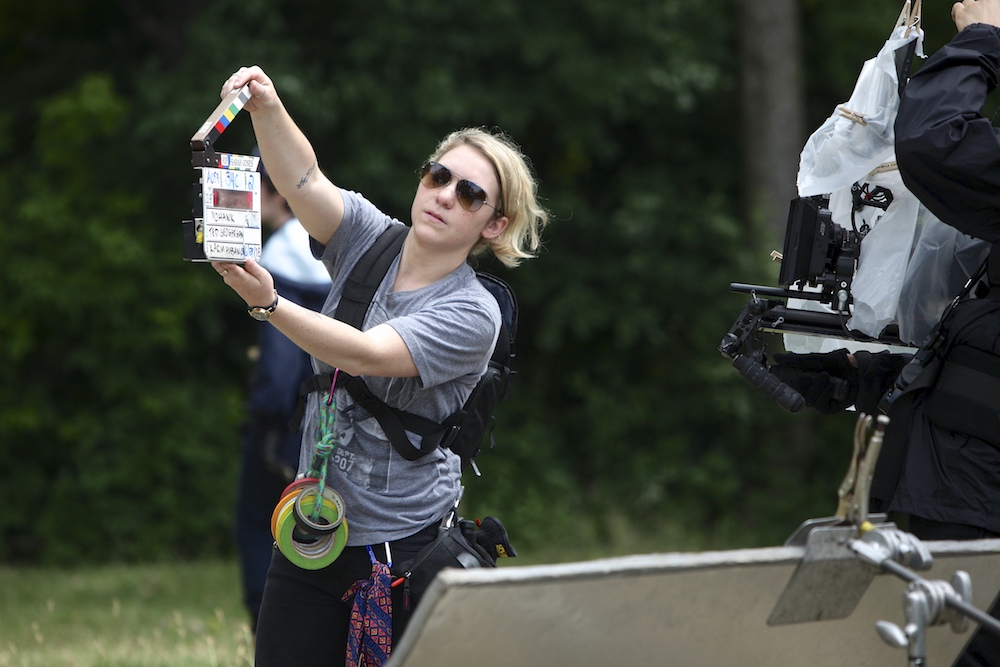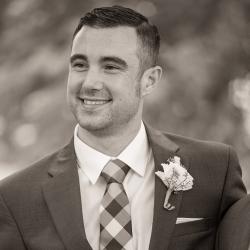Despite his Oregon roots, film producer and director Ted Geoghegan loves the Northeast. Last year, on the set of his second independent feature, Mohawk, poised for a premiere this weekend, filming took place at Skä•noñh Great Law of Peace Center, 6680 Onondaga Lake Parkway in Liverpool, which is the site formerly named Sainte Marie Among the Iroquois.

During a steaming hot late-June day, Liverpool police officers stood at opposite ends of the parkway, stopping and directing traffic as the cameras rolled. The crew was shielded by hats, umbrellas and tents. The actors, dressed in heavy 19th-century white shirted and white pant soldier garb with heavy, black boots, played out scenes during multiple takes. The natural looks of exhaustion and beads of sweat saved the makeup artists some time.
We were able to talk to the cast and crew in person, during lulls in filming and on break. Geoghegan also responded to follow up questions via email amidst a busy schedule and spending time with his family.
“I think the most common misconception about filmmaking is that it’s expected to be easy,” Geoghegan noted via email. “But from giant studio blockbusters to independent films like ours, it’s always a challenge. There are so many moving parts, and it’s always such a joy when things go well.”

The action-horror film with a solid historic base is set to debut at the Fantasia International Film Festival in Montreal, Canada, on Saturday, July 15. There isn’t any word of a local premiere, however, or even a specific national release date, although it did earn some preview space in a recent issue of Entertainment Weekly.
“I would consider doing so if the opportunity arose,” Geoghegan said. “The community there was very good to us,” adding that the crew was also well received in other parts of upstate New York.
In 2015, Geoghegan filmed his haunted house tale We Are Still Here in Palmyra and Shortsville. The favorably reviewed thriller focuses on a grieving couple after the death of their son. They move into a new residence, which houses unforeseen dwellers, and they soon realize they have to worry about their own survival.
After his directorial debut, Geoghegan and his We Are Still Here crew took advantage of Gov. Andrew Cuomo’s tax incentive program to film Mohawk. The Empire State’s efforts to entice the film industry to shoot features here has included productions such as 2013’s Adult World, with actors John Cusack and Emma Roberts prowling about the Westcott Nation during filming, as well as Irrefutable Proof and American Dresser.
The most recent production is the sports comedy Sushi Tushi or How Asia Butted Into American Pro Football, which filmed in June at various Central New York locations including Hancock International Airport, NBT Bank Stadium and the East Syracuse Film Hub. Sushi Tushi and Irrefutable Truth are directed by Syria-native Ziad H. Hamzeh and both star Sheena Colette.

There were other reasons for filming locally aside from monetary benefits and utilizing state parks and vacant land. “New York’s Film Commission is really supportive of projects such as this,” said Mohawk film editor Travis Stevens. “The tax incentives certainly make a difference. It allows us to make the argument to go there.”
Stevens added that there was more to filming here. The landscape sold them, their crew was familiar with the area and they were accessible. He said that it was like getting the band back together for Mohawk.
Geoghegan’s sophomore flick has a historical aspect. The time frame is set around the War of 1812. The title Mohawk indicates a focus on the Native people of this region. The Mohawks are one of the Five Nations associated with the Haudenosaunee or Iroquois Confederacy.
The story concerns two Mohawk protagonists, Oak (Kaniehtiio Horn, Hemlock Grove) and Calvin Two Rivers (Justin Rain, Blackstone). They are joined by British soldier Joshua (Eamon Farren, from the new Twin Peaks season on pay cable’s Showtime) in fending off vindictive American antagonists played by Ezra Buzzington (Justified), Robert Longstreet (Take Shelter) and Rochester native Jon Huber (also known as WWE superstar Luke Harper) among others.
“I’ve wanted to do this for a while, but it remained a concept for about two years. I was waiting until the right moment to expand it into a feature-length script,” said Geoghegan. “I shot the idea to my friend, Grady Hendrix, and he said he was an expert on the topic. I was like, Sure you are. I went to his office the next day, and he has a bookshelf filled with books about it.”
Hendrix, a horror writer who hails from South Carolina, currently resides in East Harlem; he’s known for his dark comedy-horror novels Horrorstör and My Best Friend’s Exorcism. “I don’t think what I write is horror, but everyone tells me that it is,” he said.
He added that “history is fabulous when looking to get material from. There is an endless supply. Once you get past the sanitized sources, you find the really fun stuff, like bloodied bodies to be left out in the field to be eaten by wild pigs.”
Hendrix is also “a nut” about the War of 1812 despite being from the South, where everyone seems to be obsessed with the Civil War. “It’s a really stupid war, and so I love it. As far as wars go, it’s bad. It was a bizarre time period in history,” said Hendrix. “The Americans and the British were both trying to pull the Native Americans on to either side. It’s similar to Afghanistan in the 1980s.”
The War of 1812 started due to British attempts to restrict trade between Canada, America and France. The three-year war is often viewed as the second war of independence for the United States.
The two major forces did coerce Native Americans into fighting on their side, but with reluctant and strategic efforts to prevent major casualties. This also occurred during the height of America’s westward expansion. Canada’s Palace of Parliament was set on fire in 1813, as well as the White House and Capitol Building during the Burning of Washington in 1814.

“The War of 1812 is almost a forgotten war, and the Mohawk campaign is one of the more forgotten parts of this forgotten war,” said Geoghegan. “It was great going into this with a creative concept, and backing it up with a lot of facts.”
“The concept plays off of a home invasion horror movie. The home in this case happens to be North America,” Hendrix said. “The invaders are the Americans and the innocent victims are the Mohawk tribesmen. They’re trying to stay neutral in a war where you’re not allowed to stay neutral.”
To begin their collaboration, Geoghegan and Hendrix sat in the same room and wrote for hours. The concept was formed and highlights to the plot were mapped out, while filling the dramatic beats in between. A lot changed, including character development; sometimes there were moments where Geoghegan didn’t know the story or preconceived ideas. Meanwhile, Hendrix said the script became a “mutant” to what it already was, but that’s not necessarily a bad thing.
Sharing the same sense of humor helped the writing team, too. “While this movie isn’t necessarily funny, when you’re sitting down with someone for 16 hours per day, a sense of humor is critical so you don’t kill each other,” Geoghegan said.
Hendrix said, “I’ve written a few things with other people before, but this is the first time we were up in each other’s grill.”
Mohawk uses the literary and literal concept of the woods as a place of mystery and unexplored, foreboding territory. There is violence, bloodshed and death, not to mention several jump scares. Although these wonders can be showcased through fiction, there are elements that add to the story: The distant past isn’t so distant.
“The thing that’s driving the horror in this is not mythology or what other genre films draw on, but politics,” said editor Stevens. “This stage of our country’s development along with contemporary circumstances, how our country engages with Native populations around the world. The suspense and violence are coming from that place.”
“There also are cinematic references to a lot of 1970s survival films like Deliverance,” Stevens added. “What can we do to put these characters in mortal danger beyond a person holding a knife at their throat?”
Part of making the film work was flexibility. Rewriting, edits and changes could occur on-set, thanks partially to the actors.
Kaniehtiio Horn, who plays the female protagonist Oak, caught the filmmakers’ attention for several reasons. Aside from her decade-long acting career, Horn is also Mohawk; she grew up on a reservation in Canada, and she speaks the language. Horn and her family helped with how the dialogue in the movie is spoken, plus historical fact checks on the culture.
“When I first got the script I was a little apprehensive, because it was two white guys writing a movie called Mohawk. There has been so much crap written, and we’re often not represented well,” Horn said. “Four pages in, I was like, ‘OK, this is good.’ They are also super-open to suggestions and notes. It honors us rather than making us feel like we’re in a museum.”

Australian actor Eamon Farren said the story can be translated into any culture or adapted for any country with indigenous people, especially in his country where, according to Farren, a lot of indigenous filmmaking is taking place. Unfortunately, the sad truth of colonization is the mistreatment of other humans.
“It taps into humanity and doesn’t shy away from the shit bits,” Farren said. “I think this is the type of way people would like to come to talking about these kinds of issues, especially in Australia and North America,” Farren said. “It’s like comedy. Make them laugh and pull the truth in.”
Actor Robert Longstreet said, “There is baggage with this period piece. People going to the theater to watch it will think a certain way based on what they think they know about that history. What appealed to me about this script was the equanimity of the characters in terms of actions they take. It will help viewers rethink. It’s about humanity and it’s not completely black and white.”
Longstreet said he has portrayed antagonists before, but his soldier-sociopath character was a new type of evil for him. “It’s weird for me, because I’m wearing goggles the whole time,” said Longstreet. “Most acting is in the eyes. My guy relies on voice, and I’ve never worked from that aspect.”
For Horn’s character, face paint also hid her facial movement. “I didn’t know what I looked like at first, and especially with my facial expressions. Everything is so hidden: no eyebrows or anything.”
The grueling location work often took its toll on Jon Huber, the 6-foot-5 professional wrestler. “I didn’t know what I was getting into,” Huber commented about the fight sequences. “The physical and mental aspects are pretty taxing. The first day we filmed for hours in the woods with these boots and carrying a bunch of gear. It’s tiring and takes the acting right out of it.”
Longstreet concurred, citing that Mohawk “was the hardest movie I’ve ever done, but it’s hard fun. We’re in the elements all day with heavy boots and gear on, plus a 20-pound musket. It’s hot, I’m old and running around. It’s real sweat and real blisters.”
According to Geoghegan, none of the post-production work was done at the $15 million Film Hub in East Syracuse. The day after filming, he headed back out to Los Angeles. Nevertheless, Geoghegan said that film commissioner Eric Vinal “showed us all of these great filming locations at Highland Forest, Pratt’s Falls and the Peace Center. It’s amazing to see these locations and realize they were plucked from the script. The icing on the cake is that we got to film in Mohawk Country.”
Even after a year has passed since Mohawk’s principal photography has been completed, Geoghegan has nothing but fond memories regarding Central New York. “It was such a pleasure to film in and around Syracuse. Our film deals with the complex history of the region, and it added a layer of authenticity to be able to film near the locations where, historically, these people lived. Having filmed two movies in upstate New York, it now feels like a home away from home.”



